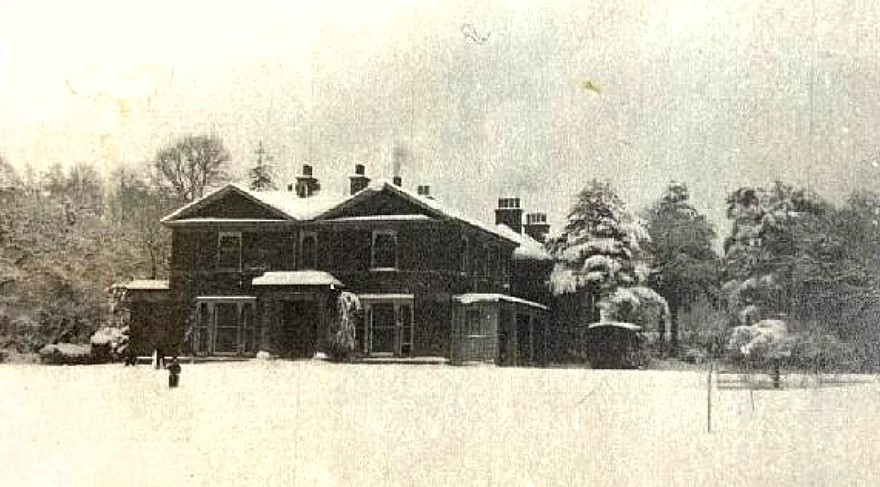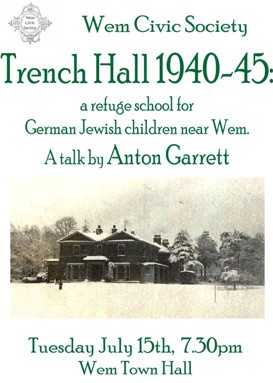
A Day at Bunce Court School (Trench Hall 1940 to 1946)
An account by Dora Schimanko, nee Kaldeck, Vienna
Bunce Court School had originally been a Jewish-German school at New Herrlingen using then new methods to teach children suffering from handicaps, especially psychological and behavioural difficulties.
In 1933 the school emigrated to England to avoid Nazi rule, but later had to move from the Kent coast to Shropshire in order to comply with British wartime regulations prohibiting "enemy aliens"
from living in defence areas. I joined the school in 1941 aged nine.
An average weekday would start off with morning gym at 7 0'clock in the morning British double summer time, i.e. 5 a.m. real time according to the sun. Even in mid- summer it was usually rather cold so we jumped into our training suits and were quite glad to get moving. Morning gym was about a quarter of an hour of exercises on the half-circle of gravel in front of the main front entrance of the building Breakfast was at eight. There was a bell ringing at a quarter past seven, then one at a quarter to eight and the last bell at five to eight. You had to be at your place at table at eight sharp when the big gong was sounded, that was when I myself usually rushed in completely out of breath, We had hardly any domestic staff, so there were various duties on a 4-week rostrum. These included sweeping rooms, laying tables, washing up etc. but were independent of duties allotted under different plans. For example, table duty meant carrying in and clearing away food and drink for the table at which you were placed (twelve children and one or two grown-ups to a table). After breakfast (tea, porridge, toast with marmalade) there were beds to be made, bedrooms to be swept and basins to be cleaned. Of course each child made its own bed, but room duties were distributed differently in every room, each of which housed between seven and twelve children. The next bell rang at a quarter to nine when lessons started.
We had no separate classrooms. Lessons were held in some bedrooms, in the dining rooms (big dining room, small dining room and library), and later on in a real classroom set up in the one-time garage. Lessons were three quarters of an hour each, but were sometimes blocked in two lessons of the same subject, giving a class, say, one and a half hours of English, enough time to read half a Shakespeare play. At eleven we had the first break. Originally soup was served in the courtyard, but this was discontinued later on. The end of lessons was at a quarter to one. The "end of lessons" bell was also the "quarter to" bell for lunch at one, People laying tables for lunch had to be quick to sweep the room and lay the tables in order to get this duty done before the "five to" bell rang. Then the gong at one. One of the perks for those on table duty was "licking out" the large bowls used for serving desserts. A team of four or five kids and one grown-up did the washing-up in the scullery. Lunch was followed by "rest hour" until half past two - the single hour during the day when the grown-ups had some peace from us kids. The nine- to eleven-year olds were supposed to lie down and sleep (or read). The older children were allowed to play on the sports field or in the "woods" (now only lawn and looking far smaller), but in the house silence was strictly enforced. Bell at half past two! Rush to the notice board in the hall to see what your job was at "practical work". These jobs, distributed daily, included cleaning rooms, darning socks, ironing laundry, bringing in coal from the pile on a wheelbarrow and all kinds of working in the garden. Also peeling potatoes, a favourite because it commonly did not take the full one and a half hours to complete, so that these children had extra spare time. Afternoon break at four, but we had no tea, only bread and butter (or jam) taken from a large tray. After that "study time" for doing homework, reading, learning by heart (especially if a child had a part in any of the numerous plays acted at the end of a term). After supper at six we had free time. This was used for playing games both out of doors and indoors (games like snakes and ladders, monopoly and chess), but also for a great range of cultural activities such as a history of the arts course, a political discussions group, a music group, the school choir, various handicrafts groups, building of model planes and anything else with enough children interested and a grown-up prepared to run a group. I usually wanted to take part in several of these spare time activities and was often sorry that I just could not be in two places at the same time. Surely I wasn't the only child in that!
Weekends were generally free, with the exception of duties. There were games of "Schlagball" (a kind of rounders), hockey, basketball "Voelkerball" going on. Saturday afternoons were devoted to a game called "Bushies and Bobbies" if the weather permitted. Instead of morning gym there was a cross-country relay organised by the highest class (16-year olds) who usually managed to get all of us going.
Such was life at Trench Hall during these years. Practically an unknown country for the denizens of Tilley or Wem who often wanted to have "nothing to do with them damn Jerrys". Although all of us, excepting the British staff and kids (perhaps a twelfth of Trench Hall 's population), were refugees from Germany, every one became registered as an "enemy alien" on his or her sixteenth birthday. With the exception of the farmer next door our first friendly contact with Wemians was made after the war when local ladies came to Trench Hall for making music. I left Trench Hall in 1946. That same summer the school returned to its home in Kent, but my mother and I returned to our own country, Austria. We have been living in Vienna ever since, although I have, meanwhile, often visited Britain on holiday.
Note: I speak of "grownups" rather than "teachers" because we had both highly qualified teachers and some highly skilled people doing staff jobs and not teaching, e.g. a theatre director looking after our stoves and managing our plays in his spare time. The above account was provided by Brian Gee. He originally obtained it from Ivan James, who provided the following background:
“I remember that the most interesting talk I have ever heard was given by Alastair Reid some years ago on the subject of Bunce Court School - a Jewish-German school evacuated to England in 1933 to escape the Nazis.
Then at the time of the Battle of Britain they were evacuated from the south coast to Tilley Green. Later there was a reunion and we had staying with us an Austrian lady who had been a pupil there. I persuaded her
to write an article which was later published in the Wemian. Alastair had researched the subject and gave a wonderful talk to one of the Wem clubs (l think it was the Probus Club).
This is a copy of the original story submitted to the Wemian by Dora Schimanco (date not remembered) and this is attached.”


A further talk, entitled 'Trench Hall, 1940-1945, a refuge school for German Jewish Children near Wem' was given by Anthony Garrett to Wem Civic Society on July 15th, 2025.
A number of people from the local area, including a leaseholder of Trench Hall (post-WWII) attended and were able to add background to the later years. It is now a specialist school for children and young people with
social, emotional, and mental health (SEMH) needs. A blue plaque on the building points to the crucial role that Trench Hall played in rescuing young Jewish people from the horrors of Nazi Germany.
WCS member, Tom Edwards, played an important part in obtaining that recognition.